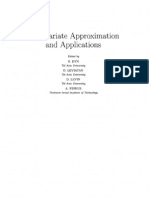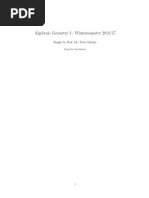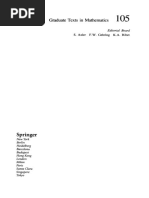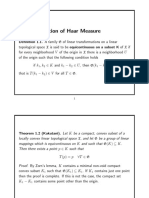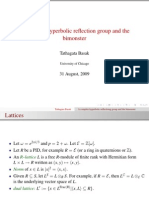Evan Chen: Transcript of Mathematics Coursework
Uploaded by
Facundo VignoloEvan Chen: Transcript of Mathematics Coursework
Uploaded by
Facundo VignoloEvan Chen
Transcript of Mathematics Coursework Last updated December 4, 2017.
Lecture notes for many of the math classes can be found at:
http: // www. mit. edu/ ~evanchen/ coursework. html .
MIT
Mathematics — Combinatorics
A+ 18.099, Discrete Analysis Seminar, Spring 2016, Peter Csikvári.
Seminar in additive combinatorics, with emphasis on Fourier analysis on Szemerédi’s theorem. Follows
Terence Tao’s textbook.
Textbook: Tao/Vu, chapters 4, 10, 11.
A- 18.217, Combinatorial Theory, Fall 2015, Richard Stanley.
Graduate combinatorics class on hyperplane arrangements and their characteristic polynomials. Partially
ordered sets, Möbius function, Möbius inversion, Möbius algebra. Intersection matroids and graphical
arrangements. Matroid theory and geometric lattices. Lattice theory (modular elements, supersolvability).
Finite field method. Random walks on arrangements, algebras on left-regular bands.
Textbook: Stanley’s Hyperplane Arrangements.
A+ 18.218, Topics in Combinatorics, Spring 2017, Alex Postnikov.
Graduate combinatorics class on algebraic combinatorics. Chip-firing and Cartan firing. Weyl groups,
Coxeter groups, Dynkin diagrams, root systems. Weyl’s characters and dimension formulas. Coxeter-
Catalan combinatorics. Schubert, Kostant, and Grothendiek polynomials.
Textbook: None.
A+ 18.434, Seminar in Theoretical Computer Science, Spring 2016, Yuan Zhou.
Seminar in theoretical computer science, with emphasis on approximation algorithms. Spectral graph
theory, error correcting codes, derandomization, expanders, communication complexity. Constraint
satisfaction problems and treewidth. LP and SDP relaxation and approximation. Rounding hierarchies,
Hardness of approximation.
Textbook: None.
— 18.S997, Graph Theory and Additive Combinatorics, Fall 2017, Yufei Zhao.
Extremal graph theory, Szemerédi’s regularity lemma and applications, pseudorandom graphs, graph
limits, Roth’s theorem and Szemerédi’s theorem on arithmetic progressions, Gowers uniformity norms,
and the Green-Tao theorem.
Textbook: None.
Mathematics — Algebra and Geometry
A 18.757, Representations of Lie Algebras, Spring 2016, Laura Rider.
Representations of Lie groups/algebras, Peter-Weyl theorem, universal enveloping algebra, PBW theorem,
Tannakian reconstruction. Jordan decompositions and toral subalgebras. Linear algebraic groups: Borel’s
fixed point theorem, Borel subgroups, parabolic subgroups, maximal tori. Diagonalizable groups, tori,
characters. Weyl group and systems of positive roots, Borel–Weil theorem.
Textbook: An Introduction to Lie Groups and Algebra by Kirillov, and Linear Algebra by Springer..
— 18.785, Number Theory I, Fall 2017, Andrew Sutherland.
Dedekind domains, decomposition of prime ideals, local fields, ramification, the discriminant and different,
ideal class groups, and Dirichlet’s unit theorem. Zeta functions and L-functions, the prime number
theorem, primes in arithmetic progressions, the analytic class number formula, and the Chebotarev
density theorem. A little local and global class field theory.
Textbook: None.
A 18.950, Differential Geometry, Fall 2015, Xin Zhou.
Starts with curves in the plane, and proceeds to higher dimensional submanifolds. Computations in
coordinate charts: first and second fundamental form, Christoffel symbols. Discusses the distinction
between extrinsic and intrinsic aspects, in particular Gauss’ theorema egregium. The Gauss-Bonnet
theorem. Geodesics. Examples such as hyperbolic space.
Textbook: Do Carmo, Geometry of Curves and Surfaces.
Other Mathematics
B+ 2.111/8.370/18.435J, Quantum Computation, Fall 2015, Seth Lloyd.
Graduate course on quantum computation. Qubits, entanglement, physics of information processing,
quantum circuits, Shor’s algorithm, etc.
Textbook: None.
A+ 14.12, Economics Applications of Game Theory, Fall 2015, Glenn Ellison.
Standard course on game theory. Utility functions, Nash equilibriums, partial information games,
subgame-perfect equilibriums, sequential equilibrium, etc.
Textbook: None.
A 14.16, Strategy and Information, Spring 2016, Mihai Manea.
A more rigorous game theory class following 14.12. Iterated dominance, perfect Bayesian equilibrium,
and sequential/perfect/proper equilibria. Cooperative games, matching allocation problems, auction and
mechanism design, bargaining.
Textbook: None.
A+ 18.821, Project Lab in Mathematics, Spring 2016, David Vogan.
How to write a paper and give a presentation (i.e. oral and written communication).
Textbook: None.
B 24.244, Modal Logic, Fall 2016, Stephen Yablo.
Propositional modal logic, Kripke frames, completeness, strict implication, modal predicate logic and its
completeness, expanding domains, contingent identity, intensional objects.
Textbook: Hughes and Cresswell.
Harvard College
A Math 55a, Honors Abstract and Linear Algebra, Fall 2014, Dennis Gaitsgory.
Groups, rings/ideals, modules, spectral theory (eigenvalues), classification of finite abelian groups, group
actions, Sylow’s Theorem, inner forms, tensor products, wedge products, representation theory (Maschke,
Schur, characters, and classification of irreducible representations of Sn ).
Textbook: None.
A Math 55b, Honors Real and Complex Analysis, Spring 2015, Dennis Gaitsgory.
Metric and topological spaces, normed vector spaces, derivatives and integrals in Rn , inverse and implicit
function theorem, ODE’s, Stoke’s theorem, holomorphic functions, Cauchy formula, Taylor expansions.
Textbook: None used officially, but loosely follows Rudin.
A Math 129, Number Fields, Spring 2015, Mark Kisin.
Algebraic number theory: number fields, factorization of ideals, class group, unit group, Frobenius
elements, local fields, ramification, weak approximation, adeles, and ideles.
Textbook: Samuel’s Theory of Numbers, (2-6).
A Math 137, Introduction to Algebraic Geometry, Spring 2015, Yaim Cooper.
Classical algebraic geometry. Affine spaces, projective and quasiprojective varieties, smoothness, birational
geometry, line bundles and divisors.
Textbook: Karen Smith’s Invitation to Algebraic Geometry (2004), chapters 1-6 and 8..
A Math 145a, Set Theory I, Fall 2014, Peter Koellner.
ZFC (ordinal and cardinal arithmetic, combinatorics, descriptive set theory), model theory (reflection,
Skolem hulls, the constructible universe, forcing), and independence of Continuum Hypothesis.
Textbook: None.
A Math 145b, Set Theory II, Spring 2015, Peter Koellner.
Large cardinals and their inner models: Covers Woodin’s recent advances toward finding an ultimate
version of Gödel’s L. Ultrafilters, extenders, (iterated) ultrapowers. Cardinals beyond Choice (Reinhardt,
super-Reinhardt, and Berkeley). Measurable, (super)strong, and (super)compact cardinals. Weak
extender models, the HOD Dichotomy Theorem, and the HOD Conjecture.
Textbook: None.
A CS 125, Algorithms and Complexity, Fall 2014, Michael Mitzenmacher and Salil Vadhan.
A new course combining Harvard’s CS 121 and CS 124. Algorithms (sorting, greedy, dynamic programming,
shortest path, linear programming, network flows), models of computation (Word RAMs, Turing machines,
finite automata), randomized and nondeterministic algorithms, NP-completeness, undecidability and
Gödel incompleteness, approximation algorithms.
Textbook: none.
San Jose State University
A+ Math 275, Topology, Fall 2012, Richard Kulbelka.
Graduate course in algebraic topology. Homotopy, fundamental group, covering projections and universal
covers, retractions, Borsuk-Ulam, van Kampen, groups of covering transformations, fiber bundles.
Textbook: Munkres’ Topology (9-11, 13).
A+ Math 179, Intro to Graph Theory, Spring 2013, Wasin So.
Hamiltonian and Eulerian properties, matching, trees, connectivity, coloring problems and planarity.
Textbook: Chartrand and Zhang, A First Course in Graph Theory (1-10).
University of California Berkeley
A+ Math 249, Algebraic Combinatorics, Fall 2014, Lauren Williams.
Simplicial complexes (shellability, CW complexes), matroids (GGMS theorem, positroids, MacPhersonian,
flag matroids), polytopes (H-vectors, g-theorem), posets (EL-shellability).
Textbook: None.
A+ Math 104, Intro to Real Analysis, Fall 2014, Charles Pugh.
The real number system. Sequences, limits, and continuous functions in R. Metric spaces. Uniform
convergence, interchange of limit operations. Infinite series. Mean value theorem and applications. The
Riemann integral.
Textbook: Pugh’s Real Mathematical Analysis.
A+ Math H113, Honors Intro to Abstract Algebra, Spring 2012, Kelli Talaska.
Groups (quotient groups, Sylow’s Theorem. Finitely generated abelian groups, semidirect products),
rings and ideals (Euclidean domains, PID’s, UFD’s), fields and field extensions.
Textbook: Dummit and Foote (1-5, 7-9, 13).
You might also like
- Brodmann M.P., Sharp R.Y.-local CohomologyNo ratings yetBrodmann M.P., Sharp R.Y.-local Cohomology516 pages
- (Allyn and Bacon Series in Advanced Mathematics) James Dugundji - Topology-Allyn and Bacon, Inc. (1966)No ratings yet(Allyn and Bacon Series in Advanced Mathematics) James Dugundji - Topology-Allyn and Bacon, Inc. (1966)464 pages
- Elliptic Curves, Modular Forms and Fermat's Last Theorem0% (1)Elliptic Curves, Modular Forms and Fermat's Last Theorem342 pages
- Higgins - Notes On Categories and GroupoidsNo ratings yetHiggins - Notes On Categories and Groupoids195 pages
- Ordinary Differential Equations and Stability Theory: An IntroductionFrom EverandOrdinary Differential Equations and Stability Theory: An IntroductionNo ratings yet
- Galois Theories by Francis Borceux, George Janelidze100% (1)Galois Theories by Francis Borceux, George Janelidze353 pages
- Explicit Brauer Induction: Cambridge Studies in Advanced Mathematics: 40No ratings yetExplicit Brauer Induction: Cambridge Studies in Advanced Mathematics: 40421 pages
- 2.8. Representations and Cohomology (Volume 1, Basic Representation Theory of Finite Groups and Associative Algebras) (Dave J. Benson - (Cambridge) ) 2004No ratings yet2.8. Representations and Cohomology (Volume 1, Basic Representation Theory of Finite Groups and Associative Algebras) (Dave J. Benson - (Cambridge) ) 2004262 pages
- Basic Algebra II Second Edition Nathan Jacobson - The full ebook version is just one click away100% (1)Basic Algebra II Second Edition Nathan Jacobson - The full ebook version is just one click away57 pages
- Several Complex Variables with Connections to Algebraic Geometry and Lie Groups 1st Edition Joseph L. Taylor 2024 Scribd Download100% (1)Several Complex Variables with Connections to Algebraic Geometry and Lie Groups 1st Edition Joseph L. Taylor 2024 Scribd Download77 pages
- Stichtenoth-Algebraic Function Fields and Codes-2008100% (1)Stichtenoth-Algebraic Function Fields and Codes-2008363 pages
- Scholze - Algebraic Geometry Course NotesNo ratings yetScholze - Algebraic Geometry Course Notes110 pages
- Several Complex Variables and Complex Geometry, Part 1 by Eric Bedford, John P. DAngelo - AMS Full E-Proceeding100% (1)Several Complex Variables and Complex Geometry, Part 1 by Eric Bedford, John P. DAngelo - AMS Full E-Proceeding280 pages
- (J.W. Gardner, R. Wiegandt) Radical Theory of Ring100% (1)(J.W. Gardner, R. Wiegandt) Radical Theory of Ring408 pages
- Notes On Lattice Theory: J. B. Nation University of HawaiiNo ratings yetNotes On Lattice Theory: J. B. Nation University of Hawaii69 pages
- Instant Ebooks Textbook Symmetrization in Analysis Albert Baernstein Ii Download All Chapters100% (12)Instant Ebooks Textbook Symmetrization in Analysis Albert Baernstein Ii Download All Chapters70 pages
- An Overview of Patterson-Sullivan Theory: J.-F. QuintNo ratings yetAn Overview of Patterson-Sullivan Theory: J.-F. Quint52 pages
- Ameya Pitale - Siegel Modular Forms - A Classical and Representation-Theoretic Approach-Springer International Publishing (2019)No ratings yetAmeya Pitale - Siegel Modular Forms - A Classical and Representation-Theoretic Approach-Springer International Publishing (2019)142 pages
- Solvable Groups Assignment by Nasir Ali KhanNo ratings yetSolvable Groups Assignment by Nasir Ali Khan6 pages
- An Invitation To General Algebra and Universal ConstructionsNo ratings yetAn Invitation To General Algebra and Universal Constructions405 pages
- (University Series in Higher Mathematics) Oscar Zariski, Pierre Samuel, I.S. Cohen - Commutative Algebra Volume I - Volume 1-D. Van Nostrand Co Inc (1958)No ratings yet(University Series in Higher Mathematics) Oscar Zariski, Pierre Samuel, I.S. Cohen - Commutative Algebra Volume I - Volume 1-D. Van Nostrand Co Inc (1958)339 pages
- (Ebook) Algebra in Action: A Course in Groups, Rings, and Fields by Shahriar Shahriar ISBN 9781470428495, 1470428490 All Chapters Instant Download100% (3)(Ebook) Algebra in Action: A Course in Groups, Rings, and Fields by Shahriar Shahriar ISBN 9781470428495, 1470428490 All Chapters Instant Download78 pages
- Goro Kato - The Heart of Cohomology-Springer (2006)100% (1)Goro Kato - The Heart of Cohomology-Springer (2006)203 pages
- Ulrich Görtz-Algebraic Geometry II Cohomology of Schemes100% (1)Ulrich Görtz-Algebraic Geometry II Cohomology of Schemes877 pages
- Cyclotomic Fields I and II - Serge LangNo ratings yetCyclotomic Fields I and II - Serge Lang449 pages
- Cohomology of Arithmetic Groups, L-Functions and Automorphic - T. Venkatamarana PDFNo ratings yetCohomology of Arithmetic Groups, L-Functions and Automorphic - T. Venkatamarana PDF132 pages
- Elliptic Curves - An Introduction R6001 PDFNo ratings yetElliptic Curves - An Introduction R6001 PDF5 pages
- Instant Download Set Theory A First Course Daniel W. Cunningham PDF All Chapters100% (4)Instant Download Set Theory A First Course Daniel W. Cunningham PDF All Chapters62 pages
- (Graduate Texts in Mathematics) Serge Lang - SL2 (R) With 33 Figures-Springer Science & Business Media (1985)100% (1)(Graduate Texts in Mathematics) Serge Lang - SL2 (R) With 33 Figures-Springer Science & Business Media (1985)432 pages
- Spectral Theory and Differential Operators D.E. Edmunds 2024 scribd download100% (10)Spectral Theory and Differential Operators D.E. Edmunds 2024 scribd download66 pages
- Basic Combinatorics: Carl G. Wagner Department of Mathematics The University of Tennessee Knoxville, TN 37996-1300100% (1)Basic Combinatorics: Carl G. Wagner Department of Mathematics The University of Tennessee Knoxville, TN 37996-1300120 pages
- Sasane Amol Sasane Sara Maad A Friendly Approach To ComplexNo ratings yetSasane Amol Sasane Sara Maad A Friendly Approach To Complex219 pages
- Automorphic Forms, Shimura Varieties, and L-Functions - Volume 1No ratings yetAutomorphic Forms, Shimura Varieties, and L-Functions - Volume 1448 pages
- Modular Representation Theory of Finite Groups Proceedings of a Symposium held at the University of Virginia Charlottesville May 8 15 1998 Michael J. Collins (Editor)download100% (1)Modular Representation Theory of Finite Groups Proceedings of a Symposium held at the University of Virginia Charlottesville May 8 15 1998 Michael J. Collins (Editor)download44 pages
- Linear Algebraic Groups: Fiona MurnaghanNo ratings yetLinear Algebraic Groups: Fiona Murnaghan13 pages
- Tathagata Basak - A Complex Hyperbolic Reflection Group and The BimonsterNo ratings yetTathagata Basak - A Complex Hyperbolic Reflection Group and The Bimonster58 pages
- Q-Deformations of Compact Lie Groups As Compact Quantum GroupsNo ratings yetQ-Deformations of Compact Lie Groups As Compact Quantum Groups85 pages
- Linear Algebra - Show That $PSL (3,4) $ Has No Element of Order $1No ratings yetLinear Algebra - Show That $PSL (3,4) $ Has No Element of Order $15 pages
- Automorphic Representations and L-Functions For The General Linear Group - Volume 2cNo ratings yetAutomorphic Representations and L-Functions For The General Linear Group - Volume 2c210 pages
- PDF Elements of the Representation Theory of Associative Algebras Volume 2 Tubes and Concealed Algebras of Euclidean Type 1st Edition Daniel Simson download100% (8)PDF Elements of the Representation Theory of Associative Algebras Volume 2 Tubes and Concealed Algebras of Euclidean Type 1st Edition Daniel Simson download85 pages
- Download (Ebook) Physical mathematics by Cahill K ISBN 9780748011872, 9781108470032, 9785558011876, 0748011870, 1108470033, 5558011874, 2300748011879, 4185558011879 ebook All Chapters PDF100% (8)Download (Ebook) Physical mathematics by Cahill K ISBN 9780748011872, 9781108470032, 9785558011876, 0748011870, 1108470033, 5558011874, 2300748011879, 4185558011879 ebook All Chapters PDF65 pages
- QFT Solutions (Including Peskin & Schroeder 3.1 and 3.4)100% (1)QFT Solutions (Including Peskin & Schroeder 3.1 and 3.4)19 pages
- Rings Whose Modules Have Maximal SubmodulesNo ratings yetRings Whose Modules Have Maximal Submodules14 pages
- Partial Differential Equations and Systems Not Solvable With Respect To The Highest Order Derivative 1st Edition Gennadii V. Demidenko100% (17)Partial Differential Equations and Systems Not Solvable With Respect To The Highest Order Derivative 1st Edition Gennadii V. Demidenko84 pages
- A Course in Algebra 1, English translation Edition Ernest Borisovich Vinberg - Download the entire ebook instantly and explore every detail100% (1)A Course in Algebra 1, English translation Edition Ernest Borisovich Vinberg - Download the entire ebook instantly and explore every detail35 pages
- Differential Geometry and Lie Groups for Physicists 1st Edition Marián Fecko - Discover the ebook with all chapters in just a few seconds100% (1)Differential Geometry and Lie Groups for Physicists 1st Edition Marián Fecko - Discover the ebook with all chapters in just a few seconds56 pages
- Full Exceptional Sequence for a Fine Quiver Moduli SpaceNo ratings yetFull Exceptional Sequence for a Fine Quiver Moduli Space47 pages
- (Ebook) Analysis on Lie Groups: An introduction by Jacques Faraut ISBN 9780521719308, 0521719305 2024 Scribd Download100% (2)(Ebook) Analysis on Lie Groups: An introduction by Jacques Faraut ISBN 9780521719308, 0521719305 2024 Scribd Download67 pages
















